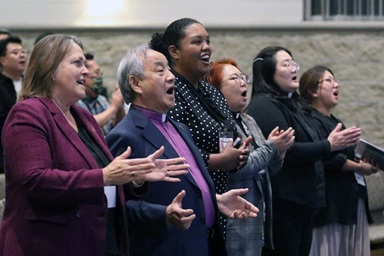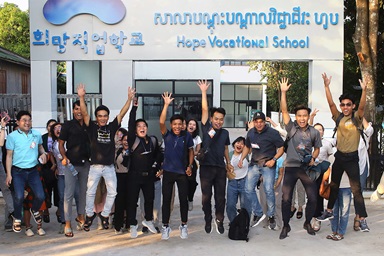One legacy of a deadly 2013 typhoon that killed more than 7,000 in the Philippines was that it helped residents prepare for a similar storm this year.
While Typhoon Hagupit was a much weaker storm than the deadly Category 5 Haiyan in 2013, many credited the low death toll of 27 to the successful evacuations of about 1 million Filipinos to safer areas. Hagupit is called Ruby in the Philippines.
A United Methodist district superintendent is calling for even more education on both storm preparedness and the effects of climate change.
“Two days before the typhoon made its landfall, people have been in evacuation centers,” said the Rev. David Cosmiano, superintendent of the Eastern Visayas District, which includes Bohol, Cebu, Olango Island, Leyte and Lapulapu.
The Rev. Ace Painit, the chair of the Board of Church and Society of the Philippines Central Conference, said the low casualty is also partly due to the use of social media to get information out, the correct forecast of the Philippine Atmospheric, Geophysical and Astronomical Services Administration, and good preparations by local governments.
Painit also called for more training, including preparation, mitigation, reduction, equipping teams and strengthening the responses of the churches. Painit said United Methodist churches should become havens for relief efforts.
Cosmiano said Hagupit ruined homes and destroyed jobs, too, but evacuations mostly kept people safe. Most people along the coast of Leyte make their living by fishing, and the storm meant they lost daily wages, which is significant for Filipinos who have meager resources, he said.
He said more than 2,000 people evacuated to the Upper Campus of Visayas State University in Baybay, about 94 kilometers from Tacloban. “The university has actually provided food for the evacuees,” Cosmiano said.
More training still needed
Cosmiano urged the United Methodist Committee on Relief and other United Methodists to intensify training on mobilization and preparation before a storm, especially in the island areas. At least four United Methodist churches were among the 687 evacuation centers that provided provided shelter during Hagupit.
Daniel Miller, a United Methodist from the Great Rivers Conference in Illinois, praised the local government for in Taft in Eastern Samar for their preparedness. Eastern Samar, where relatives of Miller’s wife live, was one of the hardest hit areas.
“Mayor Marian Libanan used resources available to ensure the safety of the community and even offered a satellite phone number for people to check the status of their relatives,” said Miller, who was in touch with relatives by telephone.
“Despite the heavy damage to personal property, the Taft local government unit did an excellent job of preparing and protecting the people by getting those especially in at-risk barangays (villages) to evacuation centers,” Miller said.
The National Disaster Risk Reduction and Management Council put property damage from Hagupit at $3.2 billion Philippine dollars ($79.5 million U.S.). That included infrastructure and agriculture of Calabarzon, Mimaropa, Bicol, Western Visayas and Eastern Visayas. More than 8,000 houses were destroyed and more than 31,000 damaged. About 2.7 million people were affected in Central and Southern Luzon, Bicol, Western, Central and Eastern Visayas, Caraga, and Metro Manila.
Climate change paramount concern
A recent United Nations report identified the Philippines as the third-most at-risk from climate change in the world, ranked behind the South Pacific island nations of Vanuatu and Tonga.
That means fighting climate change has become a paramount concern.
The Wesleyan University-Philippines, a Methodist university in Cabanatuan City, is working on educating people on climate change. The university, 70 miles north of Manila, will collaborate with the climate walk advocacy of Naderev Sano, commissioner of the Philippines Climate Change Commission.
Legazpi City in Albay province, hit severely not only by the previous typhoons but also a volcanic eruption, is home to a Climate Change Academy which offers short course focused on climate change adaptation and disaster risk reduction and management. The province had no casualties from Hagupit, but suffered severe agricultural damage of about $36 million Philippine dollars ($803,000 U.S.).
Albay Gov. Joey Salceda underscored the importance of institutionalizing the fight against climate change. That is being done through the Climate Change Academy’s strategic approach, which includes raising awareness on disaster risks, progressive training on building scenarios, climate and disaster risk assessment and management, and technical assistance for local management and planning.
Lessons Learned
Mary Ann Lucille Sering, commissioner of the Philippines’ Climate Change Commission and lead climate official for the Philippines, was at the United National Climate Change Conference in Lima, Peru, after the typhoon.
“We hope that the Philippine experience, no matter how difficult, can help unite all nations to take more concrete actions on climate change,” she said. “Our country’s experience makes our work here so much more meaningful, as this is no longer just a job for us but a fight for our survival and the future of our nation.”
*Mangiduyos is a deaconess in the United Methodist Philippines Central Conference and a professor at Wesleyan University-Philippines in Cabanatuan City.
News media contact: Vicki Brown, news editor, [email protected] or 615-742-5469.
Like what you're reading? Support the ministry of UM News! Your support ensures the latest denominational news, dynamic stories and informative articles will continue to connect our global community. Make a tax-deductible donation at ResourceUMC.org/GiveUMCom.





